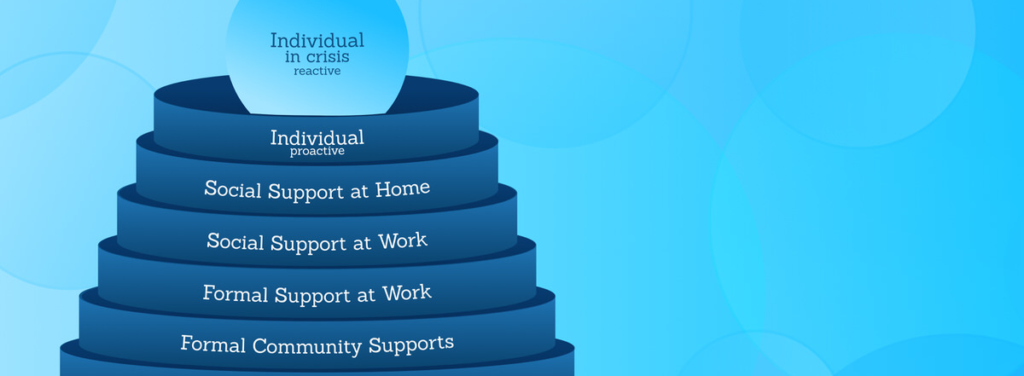Employee wellbeing can be a source of true competitive advantage, but successfully implementing wellbeing requires a unified framework for action and measurement. “Circles of Support” offers such a framework, uniting values, culture, leadership, teaming, inclusion and other important organizational concepts. The Circles of Support approach is both conceptually sound (it’s all accounted for) and actionable (it can be measured). The secret to the Circles of Support approach is a focus on human needs. Understanding and addressing unmet employee needs drives wellbeing, leading to higher employee engagement and greater organizational success.
How did wellbeing become so important in the workplace?
Wellbeing emerged as a focus area for organizations struggling to respond to a range of powerful forces, including competition for talent, chronically low employee engagement and changing attitudes toward work. These forces demanded a new approach to the employee-employer compact that opened the door for wellbeing. Arrival of the COVID-19 pandemic with its tremendous emotional toll on employees threw that door wide-open. Wellbeing is big and here to stay. Indeed, a recent Gallup study put the cost in the trillions globally! Getting it wrong can drain organizations of millions in lost productivity, medical costs, and turnover. Getting it right can lead to organizational success.
What are organizations doing about it?
Over the past decade and, accelerated by the pandemic, wellbeing has moved beyond the annual employee benefits enrollment and satisfaction survey processes. This evolution has seen a proliferation of well-meaning and occasionally effective initiatives. Employee assistance programs (EAPs) have proliferated, but utilization hovers in the single digits. Emotional intelligence and other soft skills training intended to help managers help their charges exceeds $150 billion in the U.S. alone, and U.S. employers will spend another $50 billion on wellbeing solutions. Much of this spend is wasted. A recent McKinsey study put the number of effective programs at less than half and cited lack of effective measurement as one of the major shortcomings.
How is Circles of Support different?
To truly understand wellbeing we need to move beyond the cognitive to integrate psychological, emotional, and social aspects of a person’s professional life. It is necessary, but grossly insufficient, to meet employees’ rational needs. Compensation and benefits strategies have proliferated to address rational needs. ‘Circles of Support’ addresses the emotional needs that truly deliver employee wellbeing and motivate employees to engage with their work and organization. Each circle addresses a critical organizational element, like values, culture, leadership, team dynamics, and inclusion – all within a common language of emotional needs. Furthermore, a common and powerful measurement approach means organizations can manage each circle and across circles with confidence.
We highlight below the five core wellbeing circles:
Culture: The Foundational Circle – The culture of an organization is the bedrock upon which its values, norms, and practices are built. A positive organizational culture promotes inclusivity, collaboration, and innovation. It creates an environment where employees feel valued and respected, fulfilling their need for belonging and esteem. A culture that celebrates diversity and fosters a sense of community can significantly improve job satisfaction and retention rates.
Leadership: The Guiding Circle – Leadership plays a pivotal role in shaping the culture and employees’ experience in it. Effective leaders guide those in their circle, fostering a sense of trust, empowerment and belonging among employees. This leadership circle sets the tone for open communication, professional growth, and support during challenging times. When leaders are empathetic, transparent, and supportive, they fulfill employees’ needs for respect, autonomy, and security, thereby boosting motivation and engagement.
Team Dynamics: The Collaborative Circle – Team dynamics encompass the interpersonal relationships and interactions within a team. Healthy team dynamics are characterized by mutual respect, effective communication, and shared goals. This collaborative circle meets employees’ needs for social connection and teamwork, leading to better functioning and productivity. Teams that operate within a collaborative circle support each other, enhancing individual and collective wellbeing and leading to
more successful team outcomes.
Values: The Ethical Circle – Organizational values define what an organization stands for and guides its actions and decisions. When these values align with employees’ personal values, it creates a sense of purpose and integrity. This ethical circle fulfills the need for meaningful work and moral alignment, which is crucial for total wellbeing. Employees who resonate with their organization’s values are more likely to be committed and engaged.
Diversity, Equity & Inclusion: The Inclusion Circle – Diversity, Equity & Inclusion (DE&I) initiatives are essential in creating a workplace that respects and values individual differences. The inclusive circle addresses the need for fairness, respect, and equal opportunity. Employees who operate within an inclusion circle enjoy a sense of safety and belonging that promotes wellbeing and a range of positive outcomes like teaming and creativity.
These five circles are a great place to start with your organization’s wellbeing efforts. You can also define more specific circles based on your organization’s unique characteristics and priority initiatives. As long as they are built on the framework of human needs, they are consistent and measurable. What is the Framework of Human Needs? By defining each circle of support in terms of human needs, we can simplify these complex concepts and measure their impact using a common metric. This needs-based framework focuses on what these elements do for employees, thereby providing a clear understanding of their contribution to overall wellbeing. There are four domains of human need, each with three need areas:
- Self Needs:
- Safety – The need to feel safe (physically, psychologically and financially).
- Authenticity – The need to live your authentic self.
- Potential – The need for learning and growth.
- Material Needs:
- Autonomy – The need for a sense of self agency and empowerment.
- Immersion – The need to get in the flow of your work.
- Success – The need to accomplish goals and experience success.
- Social Needs:
- Inclusion – The need to feel that you belong.
- Caring – The need to feel that you are cared for as an individual.
- Recognition – The need for acknowledgement for your contributions.
- Spiritual Needs:
- Justice – The need to know that there are a set of fair rules for how things get done.
- Ethics – The need to feel that self-interest is restrained for the good of all
- Purpose – The need for a sense of transcendent higher purpose.
So, how do we measure wellbeing through human needs fulfillment – To effectively measure the impact of these Circles of Support on employee wellbeing, organizations must use emotional measurement assessment that focus on the fulfillment of these needs. The AgileBrain emotional measurement system is a breakthrough approach to measure these emotional needs. Using rapid exposure to validated images, AgileBrain captures 144 data points in less than 3 minutes, leading to a highly accurate picture of the unmet needs of employees. The approach can be focused on any of the Circles, making it a unifying measurement system – comparable across all of the organization’s leadership, culture, team dynamics, values and DE&I initiatives.
Conclusion
The concept of “Circles of Support” offers a holistic framework for understanding and enhancing employee wellbeing. By focusing on the fulfillment of human needs through various organizational elements, companies can create a healthier, engaged and productive workforce. This approach not only benefits employees but also contributes to the overall success and sustainability of the organization. Prioritizing these Circles of Support will foster a thriving workplace where every individual feels valued and supported and the organization excels.



